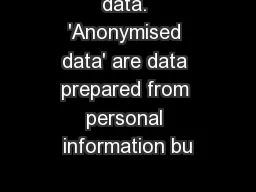/


specific issues about video at the end Why anonymise personal data in research projects Respect for confidentiality is essential to maintain trust between the public and researchers There is a str ID: 451755
Download Pdf The PPT/PDF document "data. 'Anonymised data' are data prepare..." is the property of its rightful owner. Permission is granted to download and print the materials on this web site for personal, non-commercial use only, and to display it on your personal computer provided you do not modify the materials and that you retain all copyright notices contained in the materials. By downloading content from our website, you accept the terms of this agreement.
data. 'Anonymised data' are data prepared from personal information but from (specific issues about video at the end) Why anonymise personal data in research projects? Respect for confidentiality is essential to maintain trust between the public and researchers. There is a strong public interest in maintaining confidentiality so that individuals will be encouraged, for example, to seek appropriate treatment and share information relevant to it. If members of the public become suspicious of researchers, they may choose not to take part in research in future. Wherever possible research should use unlinked, truly anonymised data. If this is not possible, the amount of personal data stored by researchers should be kept to the minimum necessary to achieve the purpose of the study. The law states that data kept should be adequate, relevant, and not excessive in relation to the project involved. Personal data should be modified as early as possible in the processing of data so that some or all of those who might see it cannot identify individuals. While anonymisation may introduce delays and risks of error, even a basic coding system can provide a safeguard against accidental or mischievous release of confidential information. Sharing of identifiable data should be limited to those who have a demonstrable need to know it as part of their role in the research project. Researchers should always consider when planning a project, when giving data to and receiving data from others and before publishing information, whether their research data may lead to the identification of individuals or very small groups. Exactly what information is potentially identifiable can only be decided on a case-by-case basis, taking into account the sample size, the way the data will be published, and all the other circumstances of the study. I am receiving data from another organisation to use in my research. Who is the best person to anonymise the data? Ideally, the organisation providing the data should anonymise it before giving it to you. This means you have received unlinked data, reducing (but not entirely removing) the risk that the data will be identifiable. Where this is not possible, it is better for the research team to anonymise the records than to use identifiable information. If I remove the subjects name have I anonymised the record? Probably not. Usually, anonymising records does not just involve removing the subjects name. If data are stored as individual data sets there is a risk that the data set could be linked to a data subject by age, postcode or medical condition. The more information included in each data set, the greater the risk of identification. Replacing a name with a pseudonym would not necessarily remove this risk. Will removing the name and address be sufficient? That will depend on the number of people involved in your study and where they are. If it is a countrywide study using many thousands of records this may be acceptable. However, in small communities it may still be possible to identify an individual even without their name and address, by a combination of other obvious characteristics such as ethnic origin, gender, disability, health the uses of the videorecording beyond the interview should be indicated (where there is to be use at conferences, seminars etc, then specific consent has to be obtained. The sell by date should be indicated ie when the data will no longer be used and will be deleted. None of this, of course, anonymises the data. In order to do so, the interview should be transcribed to English (and then anonymised as above). The data can then be used in transcribed form or if video is needed, it has to be re-recorded in sign language using a Deaf model. In the case of linguistic examples ie where the sign language articulation is the critical aspect then the item, phrase, sentence has to be re-recorded with a Deaf model. Sources This paper has been modified from one available in the Department of Exercise and Health Science web site. Their paper in turn draws upon: International Committee of Medical Journal Editors: http://www.icmje.org/ Institute of Medical Illustrators: http://www.imi.org.uk/lawethics.htm Videos, photographs and patient consent by Catherine A Hood, Tony Hope, Phillip Dove: http://bmj.com/cgi/content/full/316/7136/1009 Medical Research Council: Personal Information in Medical Research Informed consent in medical research: Journals should not publish research to which patients have not given fully informed consent - with three exceptions, Len Doyal, BMJ 1997;314;1107 (12 April): http://bmj.com/cgi/content/abstract/314/7087/1107